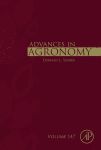Guo & Lin, 2018
Chapter 2 - Addressing Two Bottlenecks to Advance the Understanding of Preferential Flow in Soils
Guo, L. and Lin, H (2018)
Advances in Agronomy, vol 147, p 61-117
Abstract
A large number of studies over the past four decades have demonstrated the ubiquity of preferential flow in diverse soils. Because of its significant impacts on ecosystem services and environmental quality, preferential flow in soils has become a crucial issue in both the scientific community and policymaking. Despite increasing attention and research efforts on this topic, a theoretical bottleneck and a technological bottleneck continue to impede further advancement in understanding, modeling, and managing preferential flow. The theoretical bottleneck refers to the lack of a cohesive conceptual framework to integrate major space–time factors that govern the occurrence and dynamics of preferential flow in soils. The technological bottleneck refers to the inadequacy of observational techniques for detecting and quantifying complex preferential flow patterns, particularly in situ. To help breakthrough these two bottlenecks, we first summarize the dominant controls of preferential flow across a wide variety of soils and landscapes based on a synthesis of 190 case studies. A framework of six key categories of controls is developed to assess the susceptibility of various soils to preferential flow. Mechanisms of different controlling factors affecting preferential flow are then discussed using the proposed framework. To address the technological bottleneck, we summarize recent applications of soil moisture sensor networks and geophysical imaging methods to characterize preferential flow in field soils, especially repeatedly and noninvasively. Finally, a future outlook on predicting the magnitude of preferential flow and enhancing field observation of preferential flow is presented.
Citation
Guo, L. and Lin, H (2018): Chapter 2 - Addressing Two Bottlenecks to Advance the Understanding of Preferential Flow in Soils. Advances in Agronomy, vol 147, p 61-117. DOI: 10.1016/bs.agron.2017.10.002
Explore Further



